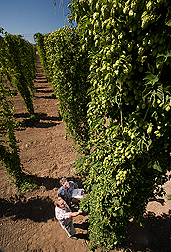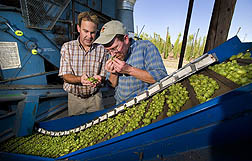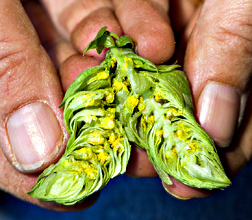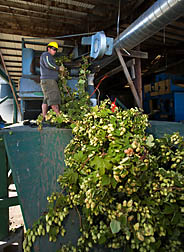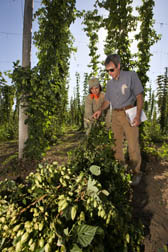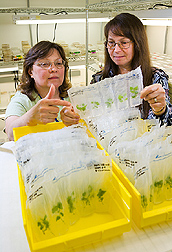HOPS: New Markets, Better Storage
Before development of modern treatment procedures, drinking impure water was a common way to pick up diseases. For centuries, beer was a popular alternative in many nations. Harmful microorganisms were removed during the production process, thanks to boiling and the addition of hops, which have natural antibiotic and antifungal properties.
Today, developed countries have plenty of safe beverage options, but hops are still an important crop. Most of the 55-60 million pounds of hops grown on U.S. soil each year are still used in beer, but an appreciation of their antimicrobial benefits has led to their use in products such as processed sugar and animal feed. Recent ARS research has developed new hops for diverse uses, along with improved storage methods to protect the genetic diversity of this important crop.
Bitter and Better
Hops are an essential beer ingredient because they contain two types of bittering acids: alpha and beta. Bitter alpha acids complement beer’s malty sweetness to give the beverage its distinct flavor. They also promote the yeast-brewing process and hinder bacterial growth. Beta acids, which have a greater effect on inhibiting microbial growth, also influence bitterness but to a much lesser extent than alpha acids.
ARS scientists are working with brewers and growers to breed new varieties of hops to improve their current uses and expand into new markets. Over the past few decades, they have developed and released several hop cultivars with traits like disease resistance, climate tolerance, and aesthetic appeal (see chart below). They’ve also bred them for high concentrations of alpha and beta acids.
|
|
Different alpha-to-beta ratios affect the physical characteristics of hops and their uses. While alpha acids are essential for brewing, their acrid flavor limits their use in other products. Low-alpha cultivars have many of the same beneficial qualities, but more diverse uses, such as in herbal teas or as nutritious feed supplements.
Hops have been used in folk remedies for everything from coughs to cancer. So what kind of hops would work best in an herbal tea? The answer is Teamaker, a variety released in 2006 by the ARS Forage Seed and Cereal Research Unit (FSCRU) at Corvallis, Oregon. Teamaker has the lowest alpha acid content (0.6 to 1.8 percent) of any commercially available hop variety. And its beta acid levels (5.4 to 13.2 percent) are significantly higher than those found in most varieties.
This extremely high beta-to-alpha ratio gives Teamaker all the health benefits of traditional hops cultivars but not their characteristic bitterness. This creates opportunities for nontraditional uses besides tea. One such use is in sugar processing, where beta acids from hops can substitute for an antibacterial called “formalin.”
|
|
Another potential use is in livestock production, where the animals can benefit from the antimicrobial properties of hops. Since low-alpha varieties are more palatable, they could be mixed into animal feed to reduce microbial and fungal illnesses. In fact, researchers elsewhere have found positive effects of using hops in poultry feed as an alternative to antibiotics.
Though antibiotics have many benefits for agricultural production, such as increased efficiency and disease management, the potential for humans to develop resistance to them through food has raised public concerns. Laws have limited or banned some antibiotics in agricultural production, creating a need for a replacement. Hops may be part of the answer.
Says FSCRU geneticist John Henning, “Brewery interest in Teamaker and similar cultivars has been low, but interest from the animal-feed and sugar-processing industries could significantly expand the hops market.”
|
|
Lower Trellises for Higher Profits
The FSCRU breeding program has recently expanded to address a management technique that could save producers as much as 30 percent in labor costs, Henning says. The method involves growing the hops on low trellises—about 10 feet high, instead of the more common 18-foot trellises used in commercial production today. Lower trellises eliminate the need for two labor-intensive aspects of production: “stringing,” in which strings are looped between the hop plants and the trellis; and “training,” in which the strongest shoots of each hop plant are wired to the trellis to encourage the hop vines to grow in clockwise spirals.
“This could have significant cost savings,” Henning says. “Even with a slight yield reduction, you could turn a profit.”
In addition to reducing labor costs, use of low-trellis production systems enables growers to move away from using orchard blast sprayers to using directed or hooded sprayers for pesticide application. Use of such sprayers results in more effective pest control while reducing the amount of pesticide applied and the potential for drift.
But not all hops are suited to low-trellis management. So Henning and his colleagues are working to identify the gene or genes responsible for shorter growth to aid selection of hop varieties that respond well to low-trellis production systems. If successful, they could save the hops industry a lot of money.
|
|
Ironing Out Storage Kinks
As part of the National Plant Germplasm System, the National Clonal Germplasm Repository (NCGR) at Corvallis maintains a hops collection that includes over 150 cultivars collected from more than 24 countries—from the Yugoslavian Ahil to the Czech Zlatan. Scientists and curators conserve genetic diversity of hops species by maintaining germplasm—genetic material such as shoot tips and seeds—from each variety.
To ensure the safety of the NCGR field collection, the scientists maintain about 250 accessions as potted plants grown in screenhouses and 57 accessions as virus-free in vitro cultures at their facilities. Thirty of these are also cryopreserved—that is, stored frozen—at the National Center for Genetic Resources Preservation in Fort Collins, Colorado. The in vitro cultures are stored at 4˚C for up to 2 years at a time, according to plant physiologist Barbara Reed.
She and her colleagues investigated how 12 hops genotypes responded to the iron formulation used in the culture medium during storage. Their observations have enabled them to improve medium-term storage of the in vitro accessions.
Just like an adult recovering from surgery and a teenager preparing for a marathon will have different dietary needs, the nutritional requirements of plants will vary according to their environment and developmental progress. Identifying those needs is essential to successful storage of germplasm.
In the past, NCGR scientists had stored hops cultures on a standard medium containing a moderate level of iron. But the researchers observed that some of the cultures became chlorotic, or yellow, suggesting iron deficiency. By adding sequestrene iron to the growth medium, the researchers found that most plants emerged greener and grew better.
“Sequestrene iron is not as tightly bound as the iron we typically use, so the plants can take it up more easily,” Reed says.
To determine whether more iron would also improve storage, the scientists compared a control group, cultured on a standard iron medium, with an experimental group, cultured on a similar medium supplemented with sequestrene iron.
Reed and her colleagues observed something paradoxical about the iron-rich media. Though most hops cultivars grew better in an iron-rich culture, the scientists found that they stored better in an environment with less iron, with an average storage length of 14 months. They have modified their storage procedure accordingly, reducing the iron content of the plants’ media about a month before storing the plants. This reduces iron deficiency without compromising storage time.
Continuing breeding, storage, and utilization research will help ensure bountiful benefits for U.S. hops production.—By Laura McGinnis, Agricultural Research Service Information Staff.

This research is part of Plant Genetic Resources, Genomics, and Genetic Improvement (#301) and Plant Diseases (#303), two ARS national programs described on the World Wide Web at www.nps.ars.usda.gov.
John A. Henning is in the USDA-ARS Forage Seed and Cereal Research Unit, 3450 S.W. Campus Way, Corvallis, OR 97331; phone (541) 738-4145, fax (541) 738-4160.
Barbara M. Reed is at the USDA-ARS National Clonal Germplasm Repository, 33447 Peoria Rd., Corvallis, OR 97333; phone (541) 738-4216, fax (541) 738-4205.
"HOPS: New Markets, Better Storage" was published in the January 2008 issue of Agricultural Research magazine.







